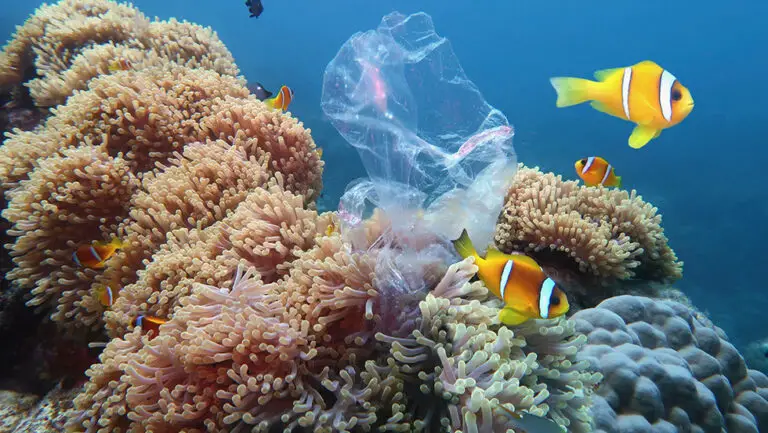With beautiful beaches that span for miles, the Maldives is known as a location with unparalleled beauty and vibrant natural life. Its clear waters swim with sea life that makes up a grand ecosystem. But what if we told you that in the future, these things may not be around any longer? With the current Maldives plastic pollution crisis, this may be the case.
It’s a sad thing to imagine, but plastic pollution is negatively affecting countries all over the world. Many countries are facing issues in natural ecosystems and even economies due to this issue. As we watch climate change and man-made pollution have further and worse impacts around the world, the future of our world is looking dire.
Through this article, we’ll be focusing on the Maldives and how this issue is affecting the country, as well as how things will look in the future and what they are doing, and what we can do about it.
Table of Contents
Is Plastic Pollution a Problem in the Maldives?

Unfortunately, yes. We’re not talking about just a tiny problem, either. Countries all over the world are suffering from environmental concerns regarding climate change, pollution, and the decline of local wildlife. It’s especially harmful to the Maldivian economy, though, considering that their main industries are tourism and fishing, which are heavily impacted by the plastic pollution crisis.
With most of the waste coming from the capital Malé and also the resorts, it’s a tough issue. The exact industry that Maldivians rely on to make an income, tourism, is causing economic and environmental issues. A double-edged sword, if you ask us. This is a concerning issue that will continue to degrade the environment if there’s no change.
What is the Plastic Pollution Crisis in the Maldives?
The plastic pollution crisis itself is the result of the Maldives not having the proper resources to address the volume of waste that’s building up in the country. Many people are burning plastic waste or simply dumping it into the sea. Throwing waste into the sea obviously damages the coral and negatively affects sea life, and burning the waste releases toxic and carcinogenic gasses. These gasses lead to detrimental health threats to Maldivians who are breathing in the polluted air.
The production of chemicals has apparently increased by 50-fold since just the middle of the last century, which is a very large jump. Scientists say that it could triple by the middle of this century if something isn’t done about the issue. Another concerning fact: the Maldives produces 365,000 tons of solid waste annually, and most of it isn’t disposed of properly. That’s a whole lot of trash.
What Does Plastic Pollution Impact?

This is a good question because it addresses the consequences of plastic pollution, which people should be aware of. This form of pollution alters habitats and natural ecosystems, which end up affecting people’s livelihoods, countries’ natural resources, and overall food production. A direct effect is that it simply takes up space, which just makes life more of a hassle.
Some of the indirect environmental issues include killing ocean marine life but also land animals. Most of you have probably heard about sea turtles choking on plastics or other marine and land animals getting caught in nets or plastic. Ocean garbage patches, which are areas with solid plastic that are held in place by currents, are growing in amount and size. Animals are trying to avoid these areas completely.
Why Does the Maldives Struggle with Plastic Pollution?

In the last decade, the Maldives islands have seen a 58% increase in waste generated per capita on local islands, as stated by Professor Karen Burke Da Silva. As mentioned earlier, this country struggles with so much plastic pollution because they don’t have the proper resources to handle it.
Since the Maldives is a country made of over 1,000 islands, much of the waste just washes up on the shores from the ocean. Commercial fishing vessels lose up to 1 million tons of fishing gear annually, mainly because of a simple lack of regulation. With the combination of this fishing gear and floating plastics, the Maldives often sees tons of plastic landing on their shores, with nowhere else to go. What is the way they fix this? They burn it or throw it back in the ocean – both terrible ways to handle it.
Thilafushi – Garbage Island
Thilafushi is an artificial island created in 1991 as a landfill where all the waste is taken for burning. Luckily due to environmental concerns for many years, the government of Maldives is now investing heavily in a new waste-to-energy project. The mission is to clean the damaged areas and handle all the waste properly, turning it into energy. Here you can learn more about this project.
Is the Maldivian Ecosystem in Danger?
Yes, and it is not only the ecosystem in danger but also the economy. Already, Maldivians are watching their coral reefs dying in a process called “bleaching”. It’s devastating to see the stunning, brightly colored corals turn white as they die. The Maldives is a series of coral atolls, and the livelihoods of the locals depend on the reefs. Tourism and fishing are both set upon the corals.
More of the sea life is dying or moving away as the corals go through bleaching. As a nation that depends on nature, the Maldives could see serious consequences in their economy and incomes in future years.
Not all hope is lost yet, though. If we can turn around this issue, and not even just in the Maldives but around the world as well, we could watch the corals continue to live and hold life.
What Maldivians Are Doing to Help

It’s been a depressing article thus far, we know. There’s light at the end of the tunnel, though. Let’s take a look at the positives and how the Maldives is taking steps to eliminate plastic waste.
Already, the Maldives has started phasing out single-use plastic products, meaning that items such as single-use plastic straws, plates, cutlery, stirrers, wrapping, and more have all been banned. It’s time to use metal water bottles and paper shopping bags.
Parley, an International NGO that’s helping countries combat their plastic pollution issues, is now assisting the Maldives with the same. Parley Maldives was formed in September 2015 and works to encourage recycling and reducing plastic waste throughout the islands.
They provide a list of recommendations for Maldivians to follow. Here are a few:
- Buy drinks in glass bottles
- Use refillable cups and bottles
- Shop with a reusable shopping bag
- Encourage friends and family members to recycle and properly dispose of plastics
For more information, check out the official website of the Ministry of Environment, Climate Change, and Technology.
The Future of The Maldivian Environment

Depending on the way things go, the future of the environment can be either bright or grim. We’re heading in the right direction with the efforts that both the government and local communities are making to stop this problem. The single-use plastic law is a huge step in the right direction. Is it enough, though?
Maldives banned the production and sales of single-use plastic in 2022.
With many of the corals already having gone through bleaching and certain impacts being reversible, all we can do is stop the issue where it is now. Even slowing the plastic pollution issue down majorly is better than the pace it’s currently going. By following the recommendations that Parley Maldives introduced, locals are already beginning to lower the plastic amount in tons per year.
Tourists can also assist by properly disposing of plastics and only using multi-use plastic. If you’re planning a trip to the Maldives, it’s important to be aware of the current environmental situation.
Even reading this article is a step in the right direction, so good job!
Let’s continue to educate ourselves and do our best to help. We can turn the tide on the Maldivian plastic pollution crisis.
Here you can learn more about the Maldives sustainability and what eco-friendly resorts in Maldives are doing.
How Can We Help Maldives & Their Environment?
FAQ
How much plastic is in the Maldives?
This is a hard number to provide or even estimate because it fluctuates, and it’s difficult to count all of it. The Maldives Ocean Plastics Alliance estimated about 43,000 tons per year.
Which country has the most plastic pollution?
You may be surprised by this answer, or you may not. The country that has the most plastic pollution is China, which is considerably logical because it’s home to over 1.4 billion people.
Is plastic allowed in the Maldives?
Plastic is still allowed in the Maldives, but only certain types. The Maldivian government has banned single-use plastics, which means that single-use straws, plates, bags, etc. are not allowed. The current plastics that are still being used are encouraged to be recycled.
Is Maldives water polluted?
Unfortunately, yes. Not to the extent where swimming isn’t safe, or you won’t still have an enjoyable experience while snorkeling and diving, but the water is growing more polluted by the day, which is affecting the natural marine life.
How can tourists help?
Tourists can leave a positive impact in the same way that the locals can. By following the single-use plastic law, properly disposing of trash, and informing other travelers of the situation, you’re helping.







